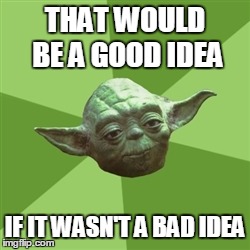The power of BAD IDEAS
- 19/10/2020
- creativity, free handout, the power of
Hever you ever ransacked your apartment, pulling your hair out, firefighters and search rescue one call away, trying to find this once-uneventful scrap of paper that, as your current self realized, contained notes for the greatest idea ever invented™️? You remember writing it down in what you had thought was the most embarrassing moment of your life™️ and then throwing it out, dismissively…
If you have at least one memory like that – I feel your pain. Bad ideas can be the greatest! Sure, I hear you naysayers, and I’m not stating all bad ideas can be turned good… (but maybe? Isn’t it us who can add a positive or negative spin to an idea? Ah, but I digress.)

It happened before! One of my favorite stories is of Alfred Fielding and Marc Chavannes, two inventors who, in the 1950s, inspired to be the faces behind a 3D wallpaper. One of the prototypes (two plastic shower curtains sealed together) turned sour and ended up as a layer of melted plastic, with air bubbles trapped in between. Not the desired effect, hence forgotten for a little while. Failure, possibility… It wasn’t till 1960 when they came back to the idea fully, rebranded their bubble wrap and offered it to IBM so the tech mogul could ship their computer parts in a cushy, protective packaging! And now, we can not only enjoy a safe way to send parcels, but also appreciate a stress-release action and sound of the bubbles popping. A failure turned genius, I say.
UNLEASH THE POWER OF BAD IDEAS
We’re quick to dismiss them, but there is much force behind bad ideas – we just need to know how to let is shine! Follow the handy rules and questions below to turn the table and use bad ideas to inspire good. Take a peek to your right. This is our backbone!
Before we start, think about a bad idea. This might be for a project you’re currently working on or just something you want to use as a challenge, but something more personal will work best. I invite you to follow along and actually do your own brainstorming while we’re learning!
Maybe you’re thinking about a bike with square wheels, that’s a bad idea, clearly (or is it?)! The best moment to start is to think about why exactly is this a bad idea? On rare occasions, you might already find an answer and figure out it isn’t. More times than less though you’ll have a bunch of reasons to dismiss your bad idea. Note them down, analyze, maybe even group them and try to what bigger „feature groups” emerge, maybe it’ll be easier to tackle later? At this stage, everything is important!
When you have your list, take a look at your bad idea again and expand the list by adding reasons what exactly is wrong with your idea. Some of them will be the same as above but don’t worry, it’s ok. As long as you keep going, it’s great, and you’ll definitely find yourself adding new reasons to the list. Don’t lock yourself and try to expand the way your mind looks at your bad idea, be broad.
Now, move your thinking towards similarities and other products. Is there anything else that share the „bad feature” of your product, but actually works as a product? Of course, looking at your list, your mind can wander in various directions, it can focus on some similarities, but not the others – and it’s cool! Don’t stress it, this is creativity at its finest, let it think and give you more inspiration! If you must, just make several lists, if not – even if you focus on one „bad feature” it will be effective.
Having that list done, look at it now and think: well, what are the differences between my bad idea, and the one that shares the „bad feature” but works? What differentiates them? Look at those differences and analyze them, see why exactly it works in the other products, what is changed, how it changed and how different it works in the other product. Make sure to connect the „bad features” with positive representations/mechanics from the other ideas. Change your point of view!
If you want to stretch your brain, try changing the context. Move your bad idea into a different country, or place it on a different medium (for example, move the bike with square wheels to a garden, or a museum). Now, at this moment, you might already have some ideas where it could be moved to have a more useful function, you might already have inspiration about what to keep from your bad idea, and what to change to make it more effective, or convenient! Try to hold on to those good features, the ones you noticed in other products, and try to keep them for your bad idea as well!
You can – and you even should – answer the same questions but from the good idea perspective: what is good about this idea, what other products share this „good feature” but don’t work, and so on. The compilation of both – the bad and the good – will kick-start new concepts! And if you look at the good from the bad list, and the bad from the good list, you’ll have a pretty cool list of what to keep, what to strive for, or what to definitely erase!
WHAT’S IN IT FOR YOU
Going over this analysis, especially starting with a bad idea, opens unknown doors and inspires connections that haven’t appeared before. It gives you the option to use the power of association and influence to steer your thinking into a new way. It’s more analytical and rooted in examples that a standard brainstorming, and will definitely help you connect random dots for a better solution!
If you don’t want to remember those questions, if you want to have that structure ready, check out this easy handout, you can jot down your notes there!


Copyright © 2017-current Gosia Pytel. All rights reserved
Terms and Conditions | Privacy and Cookie Policy || secretcats.pl🧡tworzenie stron internetowych